Feng Xu
WildCap: Facial Appearance Capture in the Wild via Hybrid Inverse Rendering
Dec 12, 2025Abstract:Existing methods achieve high-quality facial appearance capture under controllable lighting, which increases capture cost and limits usability. We propose WildCap, a novel method for high-quality facial appearance capture from a smartphone video recorded in the wild. To disentangle high-quality reflectance from complex lighting effects in in-the-wild captures, we propose a novel hybrid inverse rendering framework. Specifically, we first apply a data-driven method, i.e., SwitchLight, to convert the captured images into more constrained conditions and then adopt model-based inverse rendering. However, unavoidable local artifacts in network predictions, such as shadow-baking, are non-physical and thus hinder accurate inverse rendering of lighting and material. To address this, we propose a novel texel grid lighting model to explain non-physical effects as clean albedo illuminated by local physical lighting. During optimization, we jointly sample a diffusion prior for reflectance maps and optimize the lighting, effectively resolving scale ambiguity between local lights and albedo. Our method achieves significantly better results than prior arts in the same capture setup, closing the quality gap between in-the-wild and controllable recordings by a large margin. Our code will be released \href{https://yxuhan.github.io/WildCap/index.html}{\textcolor{magenta}{here}}.
Aerial Vision-Language Navigation with a Unified Framework for Spatial, Temporal and Embodied Reasoning
Dec 09, 2025Abstract:Aerial Vision-and-Language Navigation (VLN) aims to enable unmanned aerial vehicles (UAVs) to interpret natural language instructions and navigate complex urban environments using onboard visual observation. This task holds promise for real-world applications such as low-altitude inspection, search-and-rescue, and autonomous aerial delivery. Existing methods often rely on panoramic images, depth inputs, or odometry to support spatial reasoning and action planning. These requirements increase system cost and integration complexity, thus hindering practical deployment for lightweight UAVs. We present a unified aerial VLN framework that operates solely on egocentric monocular RGB observations and natural language instructions. The model formulates navigation as a next-token prediction problem, jointly optimizing spatial perception, trajectory reasoning, and action prediction through prompt-guided multi-task learning. Moreover, we propose a keyframe selection strategy to reduce visual redundancy by retaining semantically informative frames, along with an action merging and label reweighting mechanism that mitigates long-tailed supervision imbalance and facilitates stable multi-task co-training. Extensive experiments on the Aerial VLN benchmark validate the effectiveness of our method. Under the challenging monocular RGB-only setting, our model achieves strong results across both seen and unseen environments. It significantly outperforms existing RGB-only baselines and narrows the performance gap with state-of-the-art panoramic RGB-D counterparts. Comprehensive ablation studies further demonstrate the contribution of our task design and architectural choices.
Every Step Evolves: Scaling Reinforcement Learning for Trillion-Scale Thinking Model
Oct 21, 2025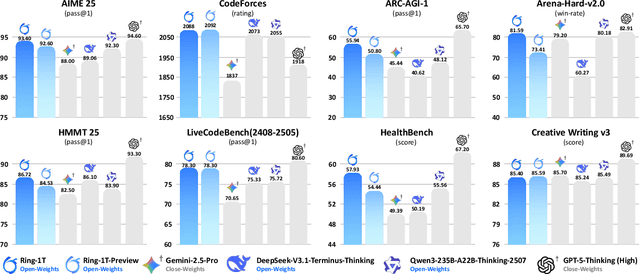
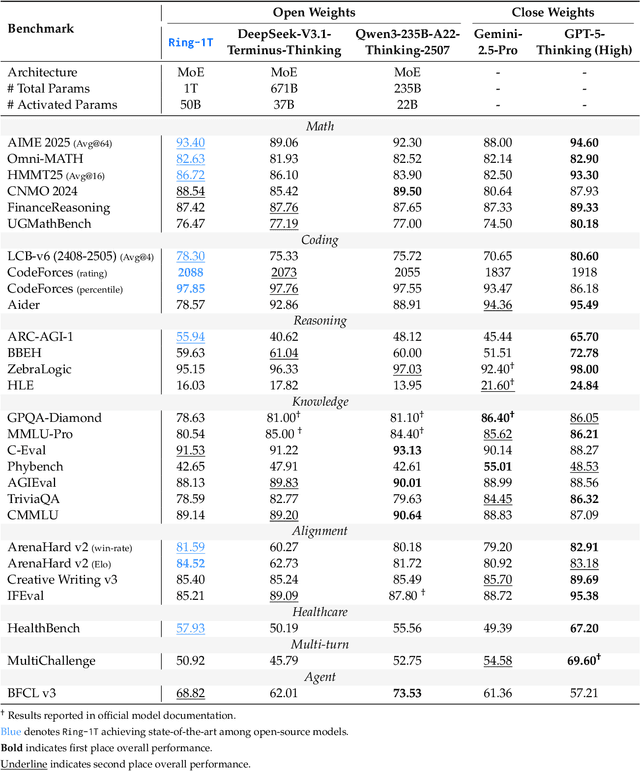
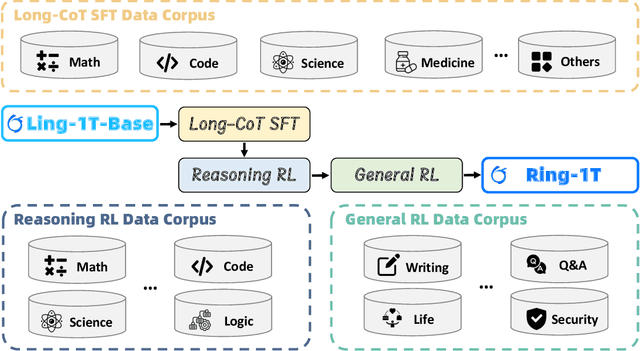
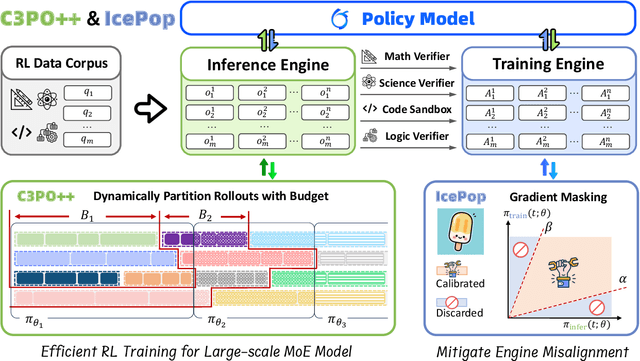
Abstract:We present Ring-1T, the first open-source, state-of-the-art thinking model with a trillion-scale parameter. It features 1 trillion total parameters and activates approximately 50 billion per token. Training such models at a trillion-parameter scale introduces unprecedented challenges, including train-inference misalignment, inefficiencies in rollout processing, and bottlenecks in the RL system. To address these, we pioneer three interconnected innovations: (1) IcePop stabilizes RL training via token-level discrepancy masking and clipping, resolving instability from training-inference mismatches; (2) C3PO++ improves resource utilization for long rollouts under a token budget by dynamically partitioning them, thereby obtaining high time efficiency; and (3) ASystem, a high-performance RL framework designed to overcome the systemic bottlenecks that impede trillion-parameter model training. Ring-1T delivers breakthrough results across critical benchmarks: 93.4 on AIME-2025, 86.72 on HMMT-2025, 2088 on CodeForces, and 55.94 on ARC-AGI-v1. Notably, it attains a silver medal-level result on the IMO-2025, underscoring its exceptional reasoning capabilities. By releasing the complete 1T parameter MoE model to the community, we provide the research community with direct access to cutting-edge reasoning capabilities. This contribution marks a significant milestone in democratizing large-scale reasoning intelligence and establishes a new baseline for open-source model performance.
Effective Gaussian Management for High-fidelity Object Reconstruction
Sep 16, 2025
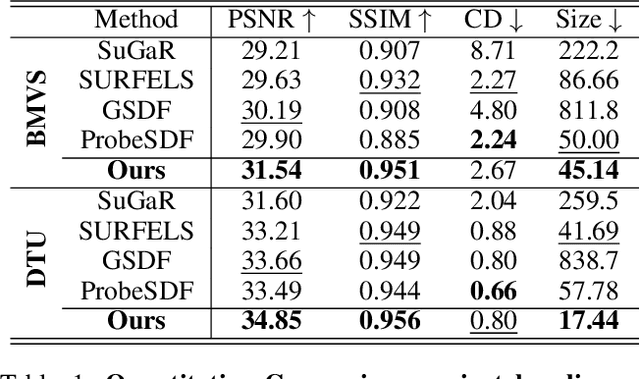
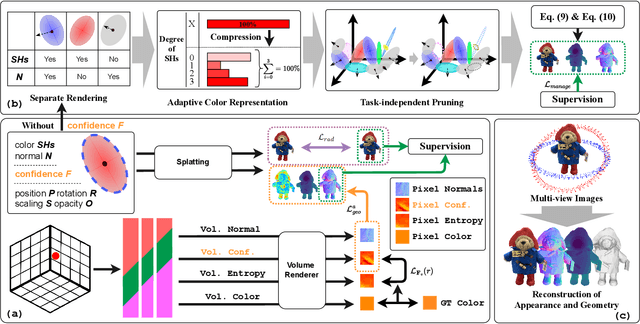
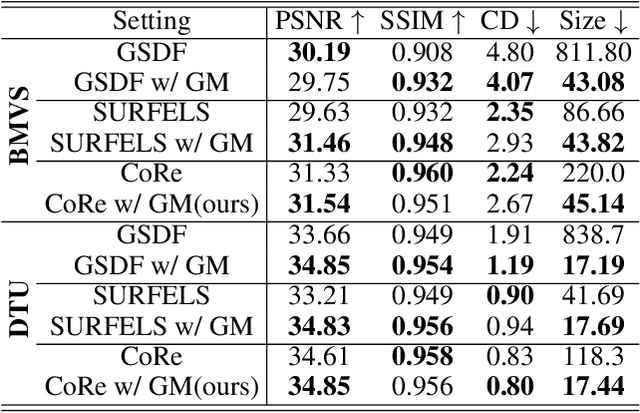
Abstract:This paper proposes an effective Gaussian management approach for high-fidelity object reconstruction. Departing from recent Gaussian Splatting (GS) methods that employ indiscriminate attribute assignment, our approach introduces a novel densification strategy that dynamically activates spherical harmonics (SHs) or normals under the supervision of a surface reconstruction module, which effectively mitigates the gradient conflicts caused by dual supervision and achieves superior reconstruction results. To further improve representation efficiency, we develop a lightweight Gaussian representation that adaptively adjusts the SH orders of each Gaussian based on gradient magnitudes and performs task-decoupled pruning to remove Gaussian with minimal impact on a reconstruction task without sacrificing others, which balances the representational capacity with parameter quantity. Notably, our management approach is model-agnostic and can be seamlessly integrated into other frameworks, enhancing performance while reducing model size. Extensive experiments demonstrate that our approach consistently outperforms state-of-the-art approaches in both reconstruction quality and efficiency, achieving superior performance with significantly fewer parameters.
DiffCap: Diffusion-based Real-time Human Motion Capture using Sparse IMUs and a Monocular Camera
Aug 08, 2025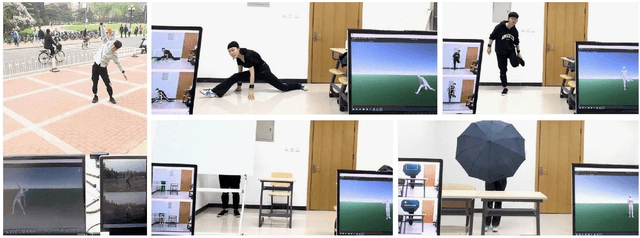
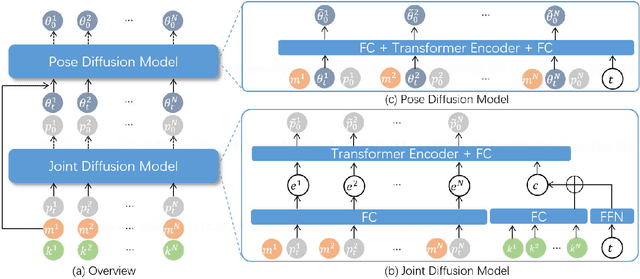
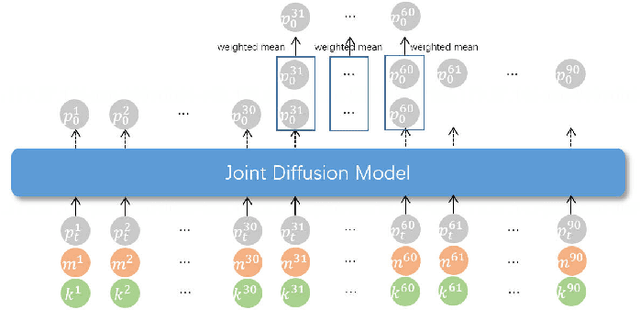
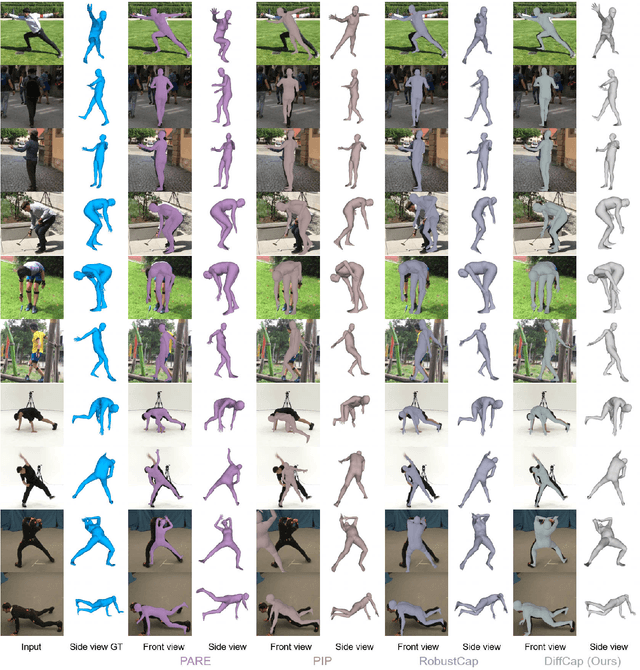
Abstract:Combining sparse IMUs and a monocular camera is a new promising setting to perform real-time human motion capture. This paper proposes a diffusion-based solution to learn human motion priors and fuse the two modalities of signals together seamlessly in a unified framework. By delicately considering the characteristics of the two signals, the sequential visual information is considered as a whole and transformed into a condition embedding, while the inertial measurement is concatenated with the noisy body pose frame by frame to construct a sequential input for the diffusion model. Firstly, we observe that the visual information may be unavailable in some frames due to occlusions or subjects moving out of the camera view. Thus incorporating the sequential visual features as a whole to get a single feature embedding is robust to the occasional degenerations of visual information in those frames. On the other hand, the IMU measurements are robust to occlusions and always stable when signal transmission has no problem. So incorporating them frame-wisely could better explore the temporal information for the system. Experiments have demonstrated the effectiveness of the system design and its state-of-the-art performance in pose estimation compared with the previous works. Our codes are available for research at https://shaohua-pan.github.io/diffcap-page.
Peering into the Unknown: Active View Selection with Neural Uncertainty Maps for 3D Reconstruction
Jun 17, 2025Abstract:Some perspectives naturally provide more information than others. How can an AI system determine which viewpoint offers the most valuable insight for accurate and efficient 3D object reconstruction? Active view selection (AVS) for 3D reconstruction remains a fundamental challenge in computer vision. The aim is to identify the minimal set of views that yields the most accurate 3D reconstruction. Instead of learning radiance fields, like NeRF or 3D Gaussian Splatting, from a current observation and computing uncertainty for each candidate viewpoint, we introduce a novel AVS approach guided by neural uncertainty maps predicted by a lightweight feedforward deep neural network, named UPNet. UPNet takes a single input image of a 3D object and outputs a predicted uncertainty map, representing uncertainty values across all possible candidate viewpoints. By leveraging heuristics derived from observing many natural objects and their associated uncertainty patterns, we train UPNet to learn a direct mapping from viewpoint appearance to uncertainty in the underlying volumetric representations. Next, our approach aggregates all previously predicted neural uncertainty maps to suppress redundant candidate viewpoints and effectively select the most informative one. Using these selected viewpoints, we train 3D neural rendering models and evaluate the quality of novel view synthesis against other competitive AVS methods. Remarkably, despite using half of the viewpoints than the upper bound, our method achieves comparable reconstruction accuracy. In addition, it significantly reduces computational overhead during AVS, achieving up to a 400 times speedup along with over 50\% reductions in CPU, RAM, and GPU usage compared to baseline methods. Notably, our approach generalizes effectively to AVS tasks involving novel object categories, without requiring any additional training.
Transformer IMU Calibrator: Dynamic On-body IMU Calibration for Inertial Motion Capture
Jun 12, 2025Abstract:In this paper, we propose a novel dynamic calibration method for sparse inertial motion capture systems, which is the first to break the restrictive absolute static assumption in IMU calibration, i.e., the coordinate drift RG'G and measurement offset RBS remain constant during the entire motion, thereby significantly expanding their application scenarios. Specifically, we achieve real-time estimation of RG'G and RBS under two relaxed assumptions: i) the matrices change negligibly in a short time window; ii) the human movements/IMU readings are diverse in such a time window. Intuitively, the first assumption reduces the number of candidate matrices, and the second assumption provides diverse constraints, which greatly reduces the solution space and allows for accurate estimation of RG'G and RBS from a short history of IMU readings in real time. To achieve this, we created synthetic datasets of paired RG'G, RBS matrices and IMU readings, and learned their mappings using a Transformer-based model. We also designed a calibration trigger based on the diversity of IMU readings to ensure that assumption ii) is met before applying our method. To our knowledge, we are the first to achieve implicit IMU calibration (i.e., seamlessly putting IMUs into use without the need for an explicit calibration process), as well as the first to enable long-term and accurate motion capture using sparse IMUs. The code and dataset are available at https://github.com/ZuoCX1996/TIC.
SAR2Struct: Extracting 3D Semantic Structural Representation of Aircraft Targets from Single-View SAR Image
Jun 07, 2025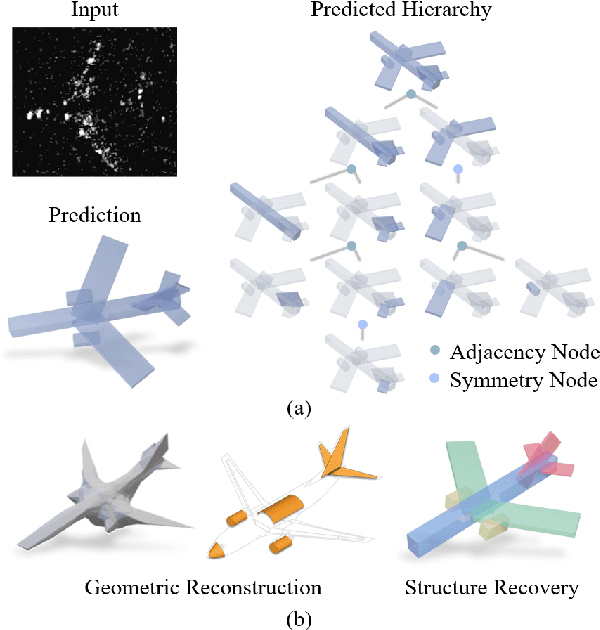
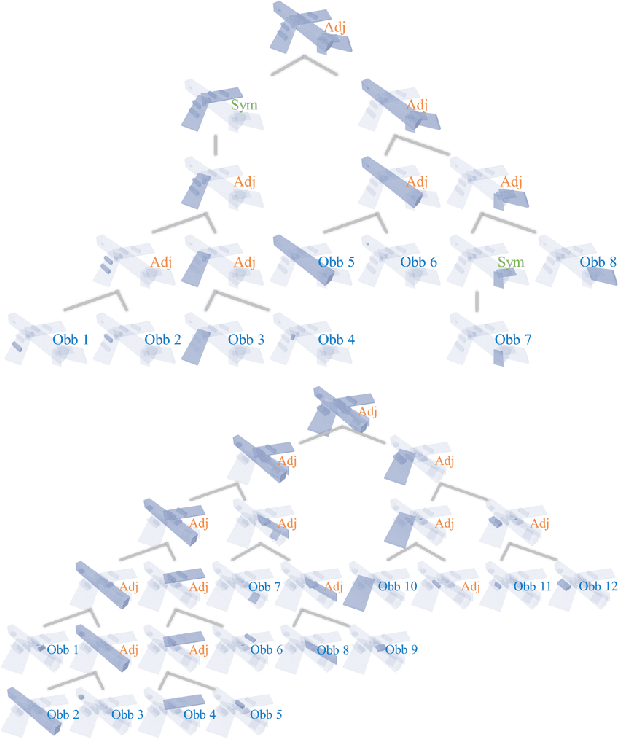

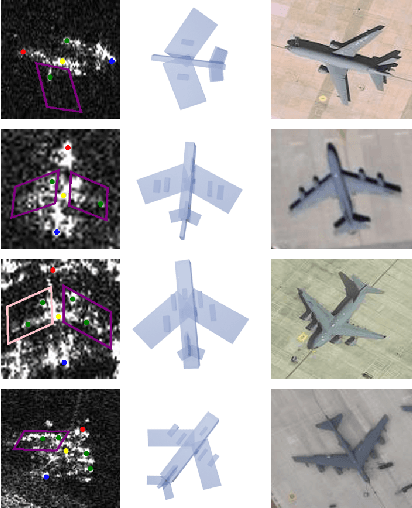
Abstract:To translate synthetic aperture radar (SAR) image into interpretable forms for human understanding is the ultimate goal of SAR advanced information retrieval. Existing methods mainly focus on 3D surface reconstruction or local geometric feature extraction of targets, neglecting the role of structural modeling in capturing semantic information. This paper proposes a novel task: SAR target structure recovery, which aims to infer the components of a target and the structural relationships between its components, specifically symmetry and adjacency, from a single-view SAR image. Through learning the structural consistency and geometric diversity across the same type of targets as observed in different SAR images, it aims to derive the semantic representation of target directly from its 2D SAR image. To solve this challenging task, a two-step algorithmic framework based on structural descriptors is developed. Specifically, in the training phase, it first detects 2D keypoints from real SAR images, and then learns the mapping from these keypoints to 3D hierarchical structures using simulated data. During the testing phase, these two steps are integrated to infer the 3D structure from real SAR images. Experimental results validated the effectiveness of each step and demonstrated, for the first time, that 3D semantic structural representation of aircraft targets can be directly derived from a single-view SAR image.
Progressive Inertial Poser: Progressive Real-Time Kinematic Chain Estimation for 3D Full-Body Pose from Three IMU Sensors
May 08, 2025Abstract:The motion capture system that supports full-body virtual representation is of key significance for virtual reality. Compared to vision-based systems, full-body pose estimation from sparse tracking signals is not limited by environmental conditions or recording range. However, previous works either face the challenge of wearing additional sensors on the pelvis and lower-body or rely on external visual sensors to obtain global positions of key joints. To improve the practicality of the technology for virtual reality applications, we estimate full-body poses using only inertial data obtained from three Inertial Measurement Unit (IMU) sensors worn on the head and wrists, thereby reducing the complexity of the hardware system. In this work, we propose a method called Progressive Inertial Poser (ProgIP) for human pose estimation, which combines neural network estimation with a human dynamics model, considers the hierarchical structure of the kinematic chain, and employs a multi-stage progressive network estimation with increased depth to reconstruct full-body motion in real time. The encoder combines Transformer Encoder and bidirectional LSTM (TE-biLSTM) to flexibly capture the temporal dependencies of the inertial sequence, while the decoder based on multi-layer perceptrons (MLPs) transforms high-dimensional features and accurately projects them onto Skinned Multi-Person Linear (SMPL) model parameters. Quantitative and qualitative experimental results on multiple public datasets show that our method outperforms state-of-the-art methods with the same inputs, and is comparable to recent works using six IMU sensors.
Consistency-aware Self-Training for Iterative-based Stereo Matching
Mar 31, 2025Abstract:Iterative-based methods have become mainstream in stereo matching due to their high performance. However, these methods heavily rely on labeled data and face challenges with unlabeled real-world data. To this end, we propose a consistency-aware self-training framework for iterative-based stereo matching for the first time, leveraging real-world unlabeled data in a teacher-student manner. We first observe that regions with larger errors tend to exhibit more pronounced oscillation characteristics during model prediction.Based on this, we introduce a novel consistency-aware soft filtering module to evaluate the reliability of teacher-predicted pseudo-labels, which consists of a multi-resolution prediction consistency filter and an iterative prediction consistency filter to assess the prediction fluctuations of multiple resolutions and iterative optimization respectively. Further, we introduce a consistency-aware soft-weighted loss to adjust the weight of pseudo-labels accordingly, relieving the error accumulation and performance degradation problem due to incorrect pseudo-labels. Extensive experiments demonstrate that our method can improve the performance of various iterative-based stereo matching approaches in various scenarios. In particular, our method can achieve further enhancements over the current SOTA methods on several benchmark datasets.
 Add to Chrome
Add to Chrome Add to Firefox
Add to Firefox Add to Edge
Add to Edge